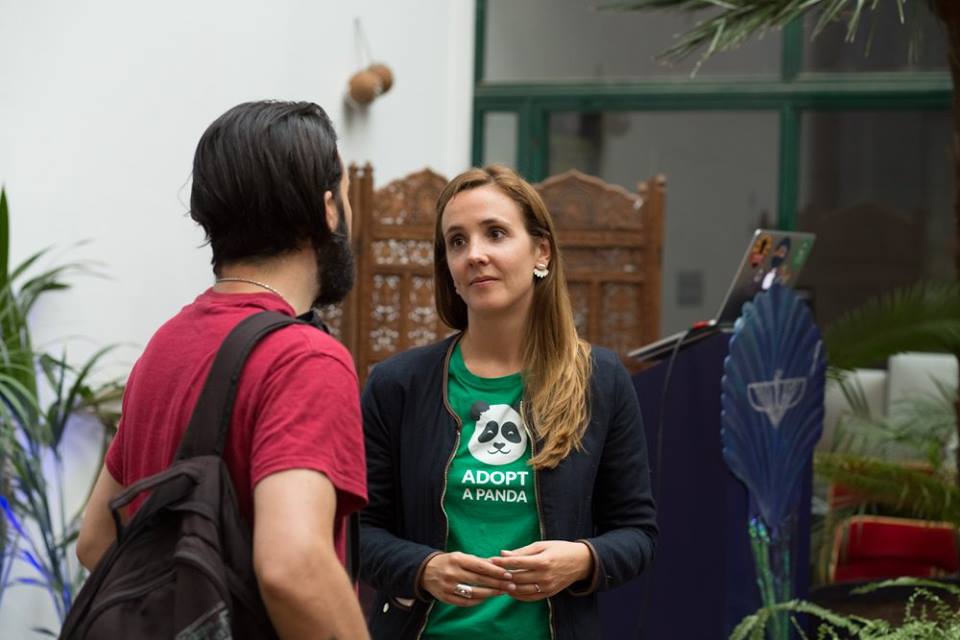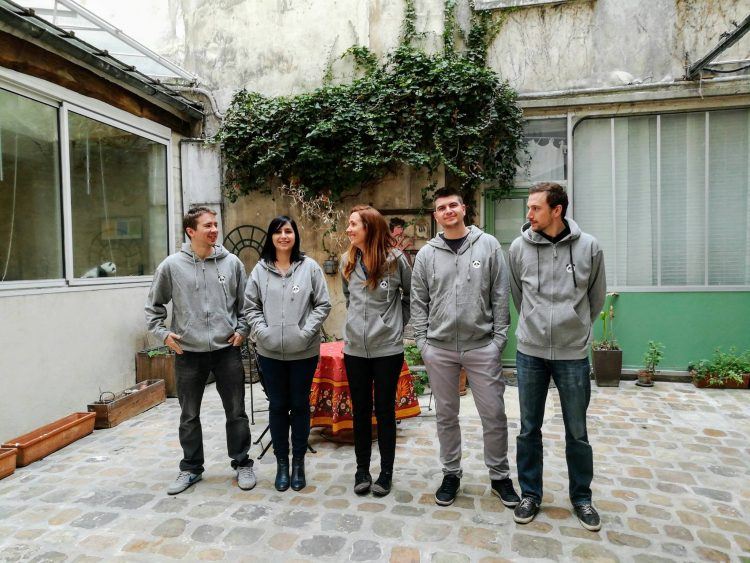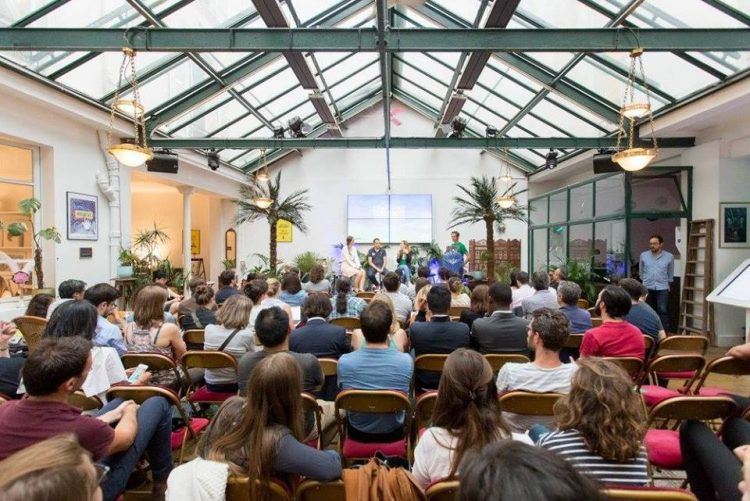
Aude Pilleron, co-founder of Pandasuite. Photo credit: Pandasuite’s Facebook page.
Aude Pilleron’s fondness for a Chinese bear was the inspiration behind the technology invented by French startup Pandasuite. “The panda is a powerful animal, but it’s also relaxed. I wanted users to know that our technology is like that,” she shares.
Pandasuite, which Pilleron co-founded with Benjamin Barbe, Jerome Dalicieux, and Nicolas Muller, is a website that enables users to create apps without coding.
It’s so easy to use that even children as young as seven years old are making apps with Pandasuite, says Pilleron. Since its launch in 2015, Pandasuite’s users have created over 20,000 apps.
Motivated by simplicity

Pandasuite’s staff of five are a lean operation. Photo credit: Pandasuite’s Facebook page.
Building a tool like Pandasuite was important to its founders because they wanted to simplify the process of creation. As Pilleron explains, “Previously, there were lots of barriers to creating apps – it was really difficult and [took] a lot of time to learn. We wanted to invent a technology that promotes freedom of creation, a tool for people with great ideas to create great apps.”
Pilleron says she first became interested in developing apps when she saw “Our Choice,” an environmental issue app backed by former U.S. vice president Al Gore that was released in 2001. It had a lot of interactivity, including a feature that allowed users to blow on the screen to mimic wind blowing. “That app was very interesting, but it was a tool that took a lot of time, money and […] technical skills to develop. Our journey at Pandasuite was about developing technology that was not expensive and required no technical knowledge to create advanced apps.”
Flexibility that gives freedom of creation

A student uploads drawings onto Pandasuite’s in an app-building workshop organized by the startup. Photo credit: Pandasuite.
According to Pilleron, what makes Pandasuite different from its competitors is its flexibility.
When Pandasuite first developed its technology, most apps in the market had a fixed set of features and could only do one thing. For example, there were apps specifically for shopping or events, but not apps that could do both. With Pandasuite, users aren’t limited to one template. They can develop a very wide variety of apps, such as museum guides, corporate presentations, kid-friendly learning tools, and magazines.
Pandasuite’s technology is made of HTML5/JavaScript and Flex hybrid technology to ensure compatibility for every browser. Pilleron explains that Pandasuite’s technology was developed because of users’ demand for a platform that would automatically generate native Android, iOS, and web (Java, Objective C, and Javascript/HTML) content at the same time, without having to develop a different app for each.
The process of creating an app on Pandasuite is straightforward. After setting up an account for free, users gain access to the Pandasuite studio: a screen with a toolbar that lets them insert features for their app, from basic details like text and images, to more advanced tools like motion sensors and blow sensors (which can detect air movement, like breaths). After making edits in the studio, the app can be previewed instantly on any device.
Most companies like iBuildApp and Zoho’s Creator charge for the process of creating the app and hosting it. But not Pandasuite – users only need to pay US$116 per month to distribute their app through any app store of their choice. Creating the app is free.
“You only pay for distribution, not creation,” says Pilleron. “We felt that if you have to pay at the beginning, this will restrain people. We want people to create first and show their colleagues. When they’re ready to release, then they pay. This way, there’s no barrier to creation, and people can be as inventive as they like.”
The main obstacle that Pandasuite faces in staying flexible is keeping up with the advances in technology. As Pilleron points out, “[We] have to be open to everything that’s happening, [be] up to date, and predict what will be the trend in technology in one to two years so we can implement it in Pandasuite.”

A Pandasuite community event. Photo credit: Pandasuite’s Facebook page.
A wide variety of users
Pandasuite’s customer profile is quite varied, with designers “who don’t know how to code [or] who used to work with a developer but now have full control over the app,” says Pilleron. “There are also project managers who work with large groups [and] use the app to replace static presentations like Powerpoint.”
French Bank BNP Paribas was one such client who sought Pandasuite’s help in creating an alternative to Powerpoint. Pandasuite was connected to the bank through OpenUp, a program that pairs companies like startups with the bank’s personnel to collaborate on company projects.
Pandasuite teamed up with Benjamin Lesage, head of the Project Office at BNP Paribas Canada. He needed help with recruiting students at annual careers fairs organized in September 2017 involving McGill University, Concordia University, HEC Montreal, and Polytechnique Montreal.
“We wanted to engage as much as possible with the students and redirect them towards our job offers. We realized we needed an app, so we posted our challenge on OpenUp and were matched with Pandasuite,” says Lesage. Pilleron trained Lesage’s team remotely, helping them to quickly create a working prototype divided into four main blocks: an infographic, a direct link to job offers, an online survey to engage with students, and an online game with a competition between the different universities.
Lesage was delighted with the results of the app. “It was a real success. Nearly 300 students answered our survey onsite, and the online game competition was very intense. We were also able to spot directly potential candidates for our interns and graduates programs.”
According to Pilleron, Pandasuite benefitted from the BNP Paribas project because it gave her experience with working with a large group and using the technology to present on a big scale.
In China, Pandsuite was instrumental in education startup Hihilulu’s efforts to create apps with interactive games for children to learn Chinese. The technology helped Hihilulu “create impactful mobile content for children to better memorize and understand the Chinese language,” shares Pilleron.
Meanwhile, La Cité de la Mode et du Design in Paris banked on Pandasuite’s geo-contextualization feature to make a museum app for an exhibition called “Studio Blumenfeld: New York 1941–1960,” which opened earlier this year. When a user’s mobile phone hovers over a photograph from the exhibit, which highlights preeminent fashion lensman Erwin Blumenfeld’s work, the app shows information the art piece.

Photo credit: Pandasuite’s Facebook page.
In terms of expansion, Pandasuite hopes to widen its French client base to go international, and it already has clients in countries like America and South Africa. But Pandasuite’s passion still lies in creating a community for the website. At the weekly workshops it organizes for users, Pilleron and her team often hear about new projects and collaborates with them to find interesting new ways of creating interactive experiences.
“We see Pandasuite as a bridge between technology and building content,” says Pilleron. “For example, we’ve put virtual reality in the toolbox. Every time a new interesting technology comes up, we put it in Pandasuite so people can experiment and do what they want.”
OpenUp is an open-platform to connect Startups and BNP Paribas innovators, keen to match directly around business opportunities. If you want to know more about this project and maybe be a part of it, hop on openup.bnpparibas and start sharing your ideas with our project managers, engaging with our experts, and applying to projects!
This post Non-developers can build their own apps thanks to this Parisian startup appeared first on Tech in Asia.
from Tech in Asia https://www.techinasia.com/bnp-non-devs-apps
via IFTTT
No comments:
Post a Comment